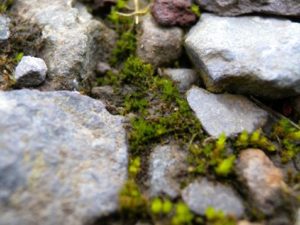Project background
Ditrichum cornubicum Paton (Cornish Path-moss) is a small acrocarpous moss found growing on old copper-rich mine spoil within the EU Habitats Directive Annex I listed habitat Calaminarian Grassland of the Violetalia calaminariae. In Ireland, this habitat type is limited to spoil derived from former mining operations and is an important habitat for a suite of rare bryophyte species which are tolerant of the heavy-metal-rich conditions where other species are unable to grow.
 Figure 1. Ditrichum cornubicum, Mountain Mine, Allihies, Co. Cork (Photo: C. Campbell)
Figure 1. Ditrichum cornubicum, Mountain Mine, Allihies, Co. Cork (Photo: C. Campbell)
There are only three sites in the world from which D. cornubicum is known; one in Ireland, at Mountain Mine, a former copper mine site at Allihies, Co. Cork, and two former copper mine sites in Cornwall, Great Britain. D. cornubicum is assessed as Critically Endangered on the Irish, European and Global Red Lists and is protected by Irish legislation through listing on the Flora (Protection) Order, 2015. Although only male plants are known and the species reproduces vegetatively, mainly through rhizoidal gemmae, the Irish population is sufficiently genetically distinct from the British populations to warrant active conservation measures.
 Figure 2. Ditrichum cornubicum habitat, Mountain Mine, Allihies, Co. Cork (Photo: C. Campbell)
Figure 2. Ditrichum cornubicum habitat, Mountain Mine, Allihies, Co. Cork (Photo: C. Campbell)
Project Aims
Conservation management measures for D. cornubicum, such as removal of topsoil to remove competing vegetation and expose metalliferous substrate, and fencing of areas where the species occurs, has taken place at the sites in Cornwall. Taking conservation techniques carried out at the Cornish sites into account, similar measures are being carried out at the Allihies site at a smaller scale. This includes scarification of the soil surface in a series of monitored plots with the aim of creating suitable substrate for this pioneer species to colonise in order to maintain populations above ground and thereby replenish the diaspore bank. Soil analyses for pH and various elements, including copper, from both the removed and exposed substrate, will allow comparison with the Cornish sites and previous studies at Allihies. Removal of dumped waste is also being carried out at the site. The success of these measures will be monitored.
Project staff and partners
Christina Campbell (National Botanic Gardens), Noeleen Smyth (National Botanic Gardens), Neil Lockhart (National Parks and Wildlife Service), Clare Heardman (National Parks and Wildlife Service) and Rory Hodd (Ecological Consultant, Nimbosa Ecology).
Publications
Campbell, C., Kelly, D.L., Smyth, N., Lockhart, N. and Holyoak, D.T., 2017. Genetic variation in the Red-Listed moss Ditrichum cornubicum Paton (Ditrichaceae) and implications for its conservation. Journal of Bryology, 39(2), pp.141-151.
